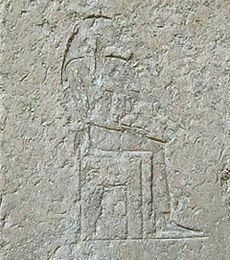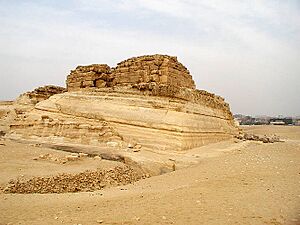Khentkaus I facts for kids
Quick facts for kids Khentkaus I in hieroglyphs |
|||||||
|---|---|---|---|---|---|---|---|
Khentkaus |
|||||||
Mut-nesut-biti-nesut-biti Mw.t-nsw-bi.tj-nsw-bi.tj Title of Khentkaus I and Khentkaus II |
|||||||
| Khentkaus depicted on her tomb | |||||||
Khentkaus I, also known as Khentkawes, was an important royal woman in ancient Egypt. She lived during the end of the Fourth Dynasty and the start of the Fifth Dynasty. She might have been the daughter of King Menkaure. Some experts believe she was married to King Shepseskaf and later to King Userkaf, who founded the Fifth Dynasty. She might also have been the mother of King Sahure.
Some historians think Khentkaus I was a regent, meaning she ruled for one of her young sons. Others even suggest she was a king herself, ruling over both Upper and Lower Egypt. Her tomb, called LG100, is in Giza, very close to Menkaure's pyramid. This closeness makes many believe she was indeed his daughter.
Contents
Life of Khentkaus I
Khentkaus I was clearly a very important person, as shown by her large burial complex. Some of her ancient titles are a bit tricky to understand. They suggest she might have been a regent, or even taken on the title of a king.
On a special granite doorway in her tomb, Khentkaus I is given titles that can be read in different ways. One way is "mother of two kings of Upper and Lower Egypt." Another way suggests she was "the king of Upper and Lower Egypt and the mother of two kings of Upper and Lower Egypt." What's more, pictures on this doorway show her with symbols of a king, including a false beard! This has led some Egyptologists (experts in ancient Egypt) to think she might have ruled as a king herself near the end of the Fourth Dynasty.
Many experts believe Khentkaus I was the daughter of King Menkaure. There's a lot of evidence that supports this idea. She might have married King Userkaf and been the mother of kings Sahure and Neferirkare Kakai. However, some historians, like Miroslav Verner, think Sahure was more likely the son of Userkaf and his wife Neferhetepes. Verner suggested Khentkaus was the mother and regent for her son Thamphthis and also the mother of Neferirkare Kakai.
Ancient king lists connect Khentkaus I to both the Fourth and Fifth Dynasties. This is because she might have been related to kings from both periods.
Royal Titles
Khentkaus I held several important titles. These titles help us understand her role in ancient Egypt, though some are debated by historians:
- King’s Mother (mwt-niswt): This means she was the mother of a king.
- Mother of Two Dual Kings (mwt-nswy-bitwy): This suggests she was the mother of two kings who ruled both Upper and Lower Egypt.
- Dual King and Mother of a Dual King (nsw-bity mwt-nsw-bity): Some experts, like Hermann Junker, read her title this way. It would mean she was a king herself and also the mother of a king.
Theories About Khentkaus I
For a long time, historians have debated Khentkaus I's exact role. This is sometimes called the "Khentkaus Problem."
In the 1930s, Selim Hassan thought Khentkaus was Menkaure's daughter. He believed she married King Shepseskaf first, and then King Userkaf. Another idea, from Ventikiev, was that her title meant "The Mother of two Kings of Upper and Lower Egypt."
Hermann Junker believed Khentkaus I was very important. He pointed to the special "pyramid town" built as part of her tomb complex. He thought her title meant she was "the King of Upper and Lower Egypt and the Mother of the King of Upper and Lower Egypt." This would mean she ruled as a king. He also suggested she was Menkaure's daughter and Shepseskaf's sister.
Other theories suggest different family connections. For example, Ludwig Borchardt thought Shepseskaf was a commoner who married Khentkaus, the king's daughter. He believed Sahure and Neferirkare Kakai were their sons.
Vivienne Callender, however, believed Khentkaus never ruled Egypt because her name wasn't written in a special royal oval shape called a cartouche. She preferred the idea that Khentkaus was the "Mother of Two Kings of Upper and Lower Egypt," and that these kings were Userkaf and Neferirkare.
These different ideas show how challenging it is to piece together history from ancient clues!
Khentkaus I's Tomb
Khentkaus I was buried in Giza, a famous ancient burial ground. Her tomb is known by several numbers, including LG 100 and G 8400. It's located in the Central Field of the Giza Necropolis. Her burial complex is quite grand, including her pyramid, a special boat pit, a valley temple, and even a small pyramid town.
The Pyramid Complex
The pyramid complex of Khentkaus I has several parts: her pyramid, a chapel, a solar boat, a pyramid city, a water tank, and storage rooms for grain. When it was first found in the 1800s, people thought her pyramid was unfinished and belonged to King Shepseskaf. But Selim Hassan started digging there in 1932 and found out more.
The chapel connected to the pyramid had a main hall and a smaller inner chapel. A secret passage in the floor of the inner chapel led down to the burial chamber. The chapel floor was made of fine limestone, and the walls had carvings, though most are now damaged. The passage and burial chamber were lined with red granite. The burial chamber was large, similar to King Shepseskaf's tomb.
Inside the burial chamber, pieces of what might have been an alabaster sarcophagus (a stone coffin) were found. A small scarab (a beetle-shaped charm) made of brown limestone was also found. This scarab seemed to be from a much later time, suggesting her tomb might have been used again for other burials later on.
Her solar boat is located southwest of the pyramid. It's a long pit carved into the rock, shaped like a boat with raised ends and possibly a roof. This boat might represent the "night-boat" that the sun-god Ra used to travel through the sky at night. If so, there might be a "day-boat" still waiting to be discovered!
Right next to the pyramid, to the east, was a pyramid city. This city was built with streets and groups of houses, each with its own storage areas and granaries. It was made of mud-bricks covered in yellow plaster. This city was likely home to the priests and servants who worked at the pyramid complex. It was built around the end of the Fourth Dynasty or beginning of the Fifth Dynasty and was used for a long time, even into the Sixth Dynasty.
The Valley Temple
A special pathway connected Khentkaus's pyramid chapel to her valley temple. This temple is very close to King Menkaure's valley temple, which again suggests a close family link between Khentkaus and Menkaure.
Near the temple, a small building called the "washing tent" was found. This was where Khentkaus's body would have been cleaned and prepared before being embalmed (preserved). Inside, archaeologists found many pieces of stone pots, pottery, and flint tools. There was also a unique stone drain that carried water away, showing advanced building skills for that time.
Both Khentkaus's and Menkaure's valley temples were built partly with mud-bricks and finished with white limestone. The main entrance to Khentkaus's temple was on the north side, which was unusual for temples back then. Entering the temple, you would walk up a wide brick path. The doorway had a porch with two columns. Inside, there was a room with four columns. Near the entrance, a statue of King Khafre (Menkaure's father) once stood. Parts of other statues, including a sphinx, were also found in the temple's entrance hall. This hall then led to storage rooms.
See also
 In Spanish: Jentkaus I para niños
In Spanish: Jentkaus I para niños



